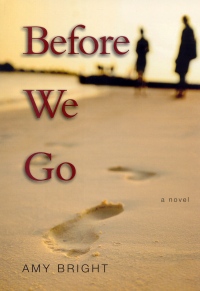| ________________
CM . . .
. Volume XIX Number 8. . . .October 26, 2012
excerpt:
Before We Go weaves the story of two teenagers who meet while leaving Victoria General Hospital on New Year’s Eve. Emily Henderson, 17, has been living with her grandmother in Victoria since her mother’s career provided an excuse for her to stay in Vancouver, thereby fuelling an increasingly strained relationship. As Emily’s grandmother’s health worsens, leaving her confined to the hospital, Emily dutifully spends most of her time in the hospital as a means to cope with the loneliness she feels when alone at home. As Emily is forced to leave the hospital at the end of visiting hours on New Year’s Eve, she meets Alex, a teenager who seemingly randomly invites Emily to burgers with him and his sister, Lucy. To avoid the loneliness that is compounded on New Year’s Eve, Emily uncharacteristically agrees and spends the evening in the company of Lucy and Alex, moving about the city of Victoria from burgers to the bowling lane and then to a party. As the story progresses, Emily eventually learns that meeting Alex and Lucy was not a random occurrence, but is the culmination of a family secret that has the capacity to change and shape the lives of the three teens. Impressively, Bright, a first-time novelist, has crafted a novel whose entire events, character development and storyline take place in less than twelve hours. Despite the short time frame, the pacing of the novel is relatively well set; never at one point did the reader feel rushed. This structured pacing is likely due to the author’s adept use at alternating blocks of dialogue with descriptive text. In this way, the reader was privy to both descriptions of the surrounding environment, which allowed for the contextualization of the characters’ actions, as well as the teenage vocabulary that permeated the dialogue, allowing for a clearer understanding of their actions and motivations. The mood of the story was pleasantly optimistic, despite underlying macabre themes of loneliness, death and abandonment, which fortunately did not overwhelm the story. Investment in each of the characters’ situations and outcomes took slightly longer than usual to develop. This could be partially explained by the delayed introduction of the main intrigue of the novel which began to take clearer form halfway through the read and which then helped coax the character development. At times, the choice of words used in scenes of dialogue seemed overly simplistic and lacked variation which consequently stifled interest in the characters. Finally, as a means to provide details of the characters’ pasts, Bright included quite a few flashbacks to key instances that had shaped or influenced the character. The transition between present and past scenes, however, often felt choppy and lacked clues which would have been helpful in determining what tense the reader was in. Teenage audiences will take a liking to Before We Go, given the age-appropriate dialogue that peppers the book’s more than 200 pages. While the read was off to a slow start, the balanced description with dialogue and the absence of a clichéd ending showcased the storyline that was impressively developed within the short time frame of this novel. Recommended Nicole Dalmer is a recent graduate of the Master of Library and Information Studies program and is now a Public Service Librarian at the Herbert T. Coutts Education and Physical Education Library at the University of Alberta in Edmonton, AB.
To comment
on this title or this review, send mail to cm@umanitoba.ca.
Copyright © the Manitoba Library Association. Reproduction for personal
use is permitted only if this copyright notice is maintained. Any
other reproduction is prohibited without permission.
NEXT REVIEW |
TABLE OF CONTENTS FOR THIS ISSUE
- October 26, 2012.
AUTHORS |
TITLES |
MEDIA REVIEWS |
PROFILES |
BACK ISSUES |
SEARCH |
CMARCHIVE |
HOME |
